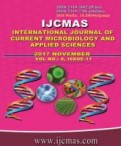


 National Academy of Agricultural Sciences (NAAS)
National Academy of Agricultural Sciences (NAAS)

|
PRINT ISSN : 2319-7692
Online ISSN : 2319-7706 Issues : 12 per year Publisher : Excellent Publishers Email : editorijcmas@gmail.com / submit@ijcmas.com Editor-in-chief: Dr.M.Prakash Index Copernicus ICV 2018: 95.39 NAAS RATING 2020: 5.38 |
Turmeric (Curcuma longa L) rhizome rot caused by Pythium aphanidermatum was one of the divesting disease and causes accountable losses. All fungicides, bioagents, botanicals and soil amendments (alone and in combination) tested in vitro for management of turmeric rhizome rot was found effective against P. aphanidermatum. However, significantly highest reduction in average mortality was recorded with Metalaxyl (RT) + its drenching (85.37 %), followed by T4 + T5 (RT) + T1 (SA) (74.54 %), Carbendazim 12 % WP + Mancozeb 63 % WP (RT) + its drenching (73.30 %), T4 + T5 (RT) + T3 (SA) (71.87 %), Bioagent consortia (RT) + Its Drenching 71.20 %), Copper oxychloride (RT) + its drenching (68.79 %), T4 + T5 (RT) + T2 (SA) (68.40 %), T4 + T5 (RT) + Bioagent consortia (SA) (68.07 %), Metalaxyl (RT) (68.80 %), Carbendazim 12 % WP + Mancozeb 63 % WP (RT) (62.60 %), Copper oxychloride (RT) (61.31 %), Trichoderma viride (RT) (54.86 %), Neem leaf extract (RT) (51.22 %) and NSKE (SA) (48.09 %).
 |
 |
 |
 |
 |